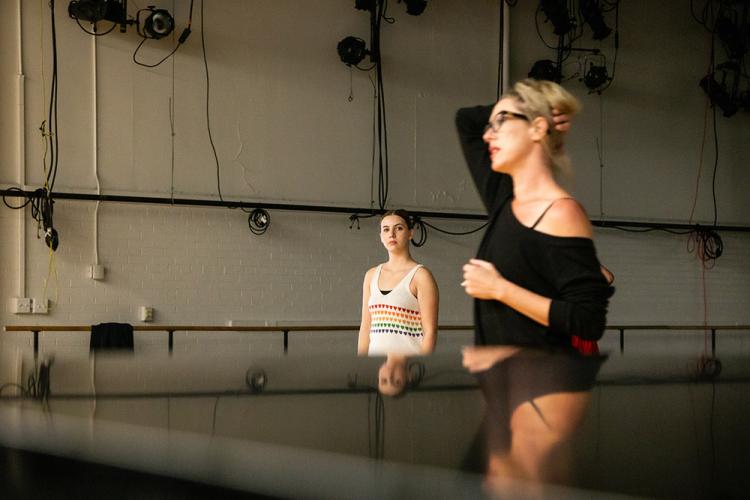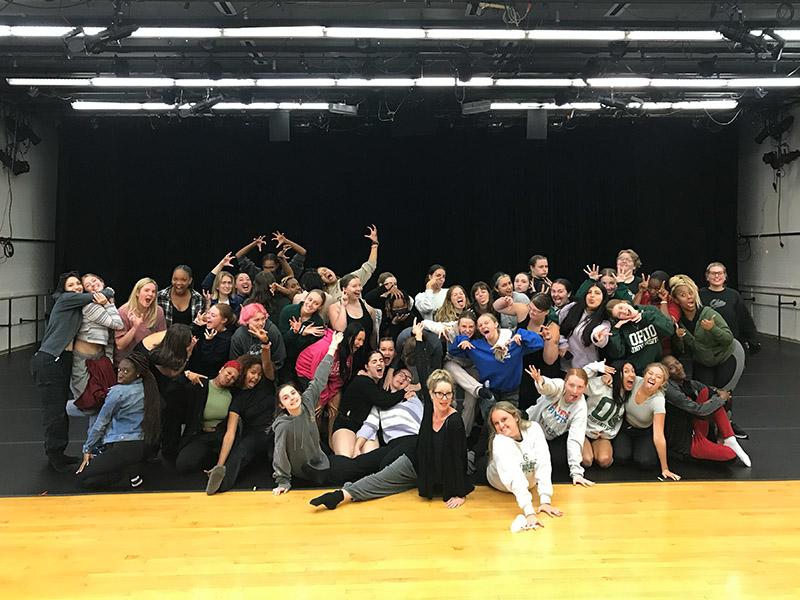
Visiting artist, ShaLeigh Comerford encourages discovery and inclusion through movement

For students in the School of Dance, the beginning of the fall semester is an exciting time, particularly for first year students.
Over the last three years, the School has brought in professional dancers from different backgrounds for a guest artist residency. This year, that guest was ShaLeigh Comerford, an Irish and Native American choreographer and Artistic Director of the Shaleigh Dance Works dance theatre company located in Durham, North Carolina.
The week-long residencies have been made possible by Dr. Christi Camper Moore’s 1804 Endowment Award grant. Her related research, in part, explores how dance identity is challenged and explored, especially as students transition to studying dance collegiately.
The residency ensured multiple points of contact with every student in the School of Dance and offered an open community class and workshop. Specifically, the residency was also designed to engage first-year dance majors through the creation of a new dance work set only on - and for- all the first-year students.
According to Camper Moore, the guaranteed performance opportunity for first-year students is important as many first-year students come from training backgrounds where regularly performing and competing is deeply embedded in their identities as dancers.
“Especially for first-year dance majors, the significance of performing has associations with students’ feelings of being capable, supporting their level of engagement, and their perceptions of the learning experience and environment,” Camper Moore said. “Moreover, having the opportunity to explicitly collaborate and get to know their new dance peers, through the residency and rehearsal process, helps to build community among first-year students and fosters their sense of place within the dance program.”
Building that strength in community is very important to both Camper Moore and Comerford, who have previously worked together. Both see value in demonstrating how that vital sense of community travels deep throughout the world of dance.
“She (Comerford) is a very strong advocate for inclusion through dance,” Camper Moore added. “I've followed her work and watched how she has has built community, so I felt that much of what she does would be a really good fit for our students.”
Comerford was first “bitten by the dance bug” early on in life when her parents took her to a ballet. Over time, the artist moved beyond ballet partly because of what she saw as its oppressive cultural nature. However, her need to dance remained.
“Basically, I fell in love with dance again going to clubs and dancing all night long. I would be there early, when it wasn’t cool to show up yet, and I would stay until close. I just couldn't get enough," Comerford said.
The world of dance began to unfold for her when she landed a position with a regional ballet company in Virginia. Later, while traveling to Tel Aviv to study with the Batsheva Dance Company, she began to see dance in a different way.
With Batsheva, she learn a movement style, Gaga, which Comeford further developed—creating her own movement vocabulary, which she called ShaGa.
“I learned their movement language, which helped me realize how I can put together everything within a framework through my own lens that encourages more agency, more autonomy, more choice, and more self-empowerment, creating something that removes the eyes of self-judgment through caring about image," Comeford explained.
ShaGa was developed throughout her life and career as a social worker, intuitive, advocate, survivor, dancer, choreographer and teacher. Over time, the knowledge and experience she gained has gradually transformed into this living movement practice.

The ShaGa way of free thinking and independence through movement is exactly what Comerford passed down to the first-year students she worked with during her residency at OHIO.
“What I was really trying to do was tackle how to take some of these broader ideas and distill them down to an hour and 20 minutes," Comeford said. "Similar to my framework of ShaGa, I tried to put the power back in student's hands.”
She does this by asking every student what they hope to gain, what thoughts they may be curious about or wrestling with.
“I've really let the students guide me in terms of what they're hoping for. I work to find what gaps I can fill from the experiences that I have,” she said.
“ShaLeigh structured her classes to cater to the needs and wants of the dancers," Erica Lewis, a fourth year B.F.A. dance major, said. "Her movement corrections are always given through a lens of encouragement and discovery… not only did I feel supported within her technique classes, but also when she came and spoke to our senior capstone class. She validated my feelings of how scary it is having to bridge the gap from academia to a career in dance. She provided lots of useful tools and resources on financial literacy for artists, networking, and marketing for dancers, and most importantly how to know your self-worth within a competitive industry. This past week I have left every class feeling more and more inspired.”
Addyson Williams, a first year B.F.A. dance major added that "working with ShaLeigh has been an amazing experience. Working with her to set the new dance piece has been a very different experience than what I was previously used to. It was fast paced and very intense, but I never felt that I was behind.”
Williams also expressed her gratitude for being able to perform a full piece.
“Coming into my first year as a dance major, I wasn’t sure I would get to perform. I think it’s important for first-year dance majors to get this opportunity," Williams said.
Abby White (she/her), first-year, B.F.A. dance major called the engagement an amazing experience.
Sshe continuously pushed us to bridge the gap between being a professional dancer and a student, pushing all of the dancers to develop their artistry and connect with the movement," White said. "She also emphasized making sure that every dancer's needs were met and heard throughout the entire rehearsal process.”
“ShaLeigh pushed me to tap into my body’s potential through the use of breath and power from within to become a more dynamic mover. I can use these skills in future classes and empower the community movers I work with to do the same," Nicole Derthick (she/her) who is pursuing an M.A. in Community Dance, said.
For Ian Baptiste, an MA student in community dance, Comerford’s teachings inspired him to do more in the dance community.
“ShaLeigh mentioned in class that being transparent has been an important part of her experience in terms of creating community and working with community. She also discussed ableism, and how the field of dance can advocate for individuals with various disabilities," Baptiste said. "In addition, I found her technique classes very interesting. It made me feel like doing more and that her work is something I could also use in my classes back in Trinidad and Tobago.”
Comerford reflected on her favorite part of her residency, saying that “this might sound super cheesy, but I have to say it's the spark that I see in the eyes of the students, the curiosity, and a hunger they seem to have, there's a real passion. That’s something I always tell my dancers, you can teach technique, but you can’t teach passion.”
Comerford's new work, "their hands, reaching," will premiere at the School of Dance’s annual Winter Dance Concert on Feb. 16 and 17, 2024.
